英语八种动词时态讲解
初中英语时态8种基本时态讲解
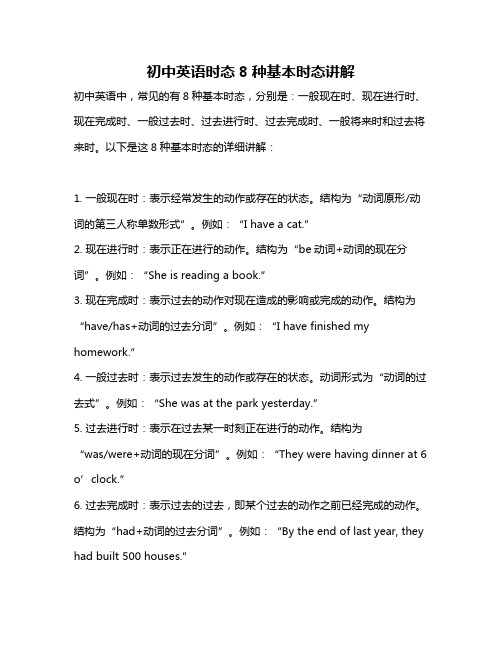
初中英语时态8种基本时态讲解初中英语中,常见的有8种基本时态,分别是:一般现在时、现在进行时、现在完成时、一般过去时、过去进行时、过去完成时、一般将来时和过去将来时。
以下是这8种基本时态的详细讲解:1. 一般现在时:表示经常发生的动作或存在的状态。
结构为“动词原形/动词的第三人称单数形式”。
例如:“I have a cat.”2. 现在进行时:表示正在进行的动作。
结构为“be动词+动词的现在分词”。
例如:“She is reading a book.”3. 现在完成时:表示过去的动作对现在造成的影响或完成的动作。
结构为“have/has+动词的过去分词”。
例如:“I have finished my homework.”4. 一般过去时:表示过去发生的动作或存在的状态。
动词形式为“动词的过去式”。
例如:“She was at the park yesterday.”5. 过去进行时:表示在过去某一时刻正在进行的动作。
结构为“was/were+动词的现在分词”。
例如:“They were having dinner at 6 o’clock.”6. 过去完成时:表示过去的过去,即某个过去的动作之前已经完成的动作。
结构为“had+动词的过去分词”。
例如:“By the end of last year, they had built 500 houses.”7. 一般将来时:表示将来要发生的动作或存在的状态。
结构为“will+动词原形”或“am/is/are going to+动词原形”。
例如:“We will visit the museum next week.”8. 过去将来时:表示从过去的某一时刻看,将来要发生的动作或存在的状态。
结构为“would+动词原形”或“was/were going to+动词原形”。
例如:“He said he would come back soon.”以上就是初中英语8种基本时态的讲解,希望对你有帮助!。
英语八大时态总结表
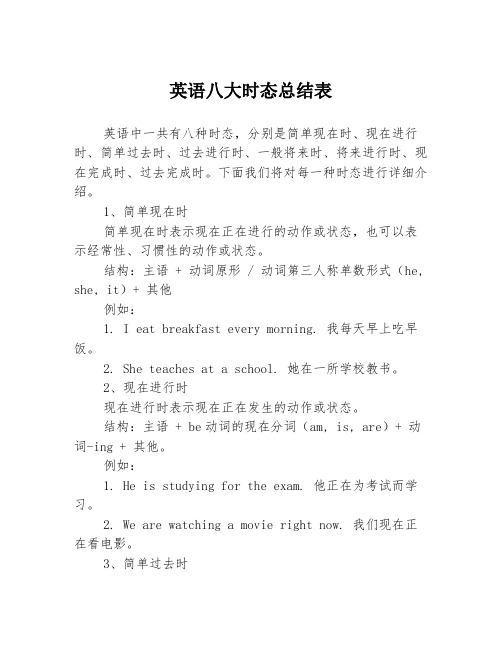
英语八大时态总结表英语中一共有八种时态,分别是简单现在时、现在进行时、简单过去时、过去进行时、一般将来时、将来进行时、现在完成时、过去完成时。
下面我们将对每一种时态进行详细介绍。
1、简单现在时简单现在时表示现在正在进行的动作或状态,也可以表示经常性、习惯性的动作或状态。
结构:主语 + 动词原形 / 动词第三人称单数形式(he, she, it)+ 其他例如:1. I eat breakfast every morning. 我每天早上吃早饭。
2. She teaches at a school. 她在一所学校教书。
2、现在进行时现在进行时表示现在正在发生的动作或状态。
结构:主语 + be动词的现在分词(am, is, are)+ 动词-ing + 其他。
例如:1. He is studying for the exam. 他正在为考试而学习。
2. We are watching a movie right now. 我们现在正在看电影。
3、简单过去时简单过去时表示在过去某个时间发生的动作或状态。
结构:主语 + 动词的过去式 / 动词的第二人称单数形式(you)+ 其他。
例如:1. They went to the beach last summer. 他们去年夏天去了海滩。
2. She talked to her friend on the phone yesterday. 她昨天给她的朋友打电话聊天了。
4、过去进行时过去进行时表示过去某个时间正在进行的动作或状态。
结构:主语 + be动词的过去分词(was, were)+ 动词的现在分词(-ing)+ 其他例如:1. They were playing soccer when it started raining. 下雨的时候他们正在踢足球。
2. She was studying when her phone rang. 她在学习的时候接到了电话。
八大时态讲解(共26张PPT)

0 一般过去将来时:
He was sixty-eight. In two years he would be seventy.
I knew you would agree.
0 现在英进行语时的: 动词时态(进行) What are you doing?
算;
如:I am going to listen to music. (我打算听音乐) will /shall 表示未事先思考或为计划过的意图
如:It will be Christmas soon .(很快就圣诞节了)
4. 现在进行时态( The Present Continuous Tense )
5、我们离开广州六年了。
We have left Guangzhou for 6 years . ×
We have been away from Guangzhou for 6
years .
3.常见句型
1) 主句(现在完成时)+since 从句(一般过去时).
2) It is +一段时间+ since 从句(一般过去时).
has gone to
He said had seen this morning, …ago, etc
that he _________the film many 如果明天不下雨,我们将去野营。
He has borrowed the pen for three days .
times. 现在进行时态( The Present Continuous Tense )
was /were going to +动词原形
一般现在时,一般过去时,一般将来时及现在进行时
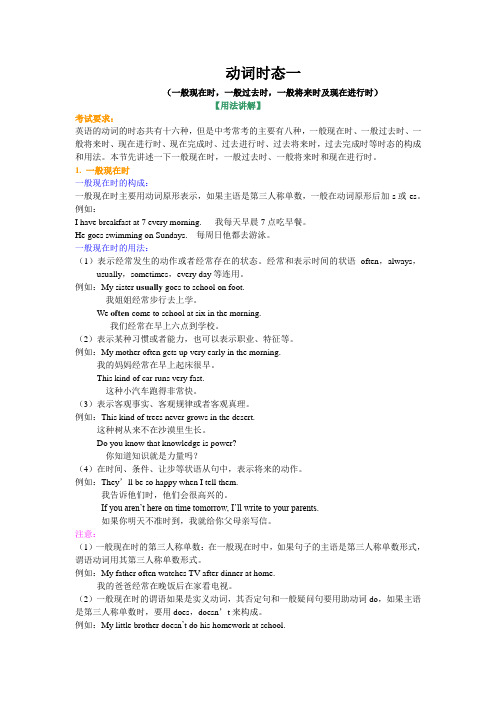
动词时态一(一般现在时,一般过去时,一般将来时及现在进行时)【用法讲解】考试要求:英语的动词的时态共有十六种,但是中考常考的主要有八种,一般现在时、一般过去时、一般将来时、现在进行时、现在完成时、过去进行时、过去将来时,过去完成时等时态的构成和用法。
本节先讲述一下一般现在时,一般过去时、一般将来时和现在进行时。
1. 一般现在时一般现在时的构成:一般现在时主要用动词原形表示,如果主语是第三人称单数,一般在动词原形后加-s或-es。
例如:I have breakfast at 7 every morning. 我每天早晨7点吃早餐。
He goes swimming on Sundays. 每周日他都去游泳。
一般现在时的用法:(1)表示经常发生的动作或者经常存在的状态。
经常和表示时间的状语often,always,usually,sometimes,every day等连用。
例如:My sister usually goes to school on foot.我姐姐经常步行去上学。
We often come to school at six in the morning.我们经常在早上六点到学校。
(2)表示某种习惯或者能力,也可以表示职业、特征等。
例如:My mother often gets up very early in the morning.我的妈妈经常在早上起床很早。
This kind of car runs very fast.这种小汽车跑得非常快。
(3)表示客观事实、客观规律或者客观真理。
例如:This kind of trees never grows in the desert.这种树从来不在沙漠里生长。
Do you know that knowledge is power?你知道知识就是力量吗?(4)在时间、条件、让步等状语从句中,表示将来的动作。
例如:They’ll be so happy when I tell them.我告诉他们时,他们会很高兴的。
英语中八大时态

英语中八大时态英语中共有八种时态:一般现在时、一般过去时、一般将来时、现在进行时、现在完成时、过去完成时、过去将来时和将来完成时。
一般现在时:一般现在时表示现在持续的动作、状态、习惯和真理,可以用一般现在时表示将来某个动作发生的可能性。
一般现在时用助动词do / does来表示,助动词的位置是句首,动词的形式要变成原形,例如:He usually goes to school at 6 o'clock every day. 他每天通常六点上学。
一般过去时:一般过去时表示过去发生的动作和状态,什么时候发生的都可以用一般过去时表示,一般过去时用助动词did来表示,助动词的位置是句首,动词的形式要变成过去式,例如:I went tothe cinema last night. 我昨晚去电影院了。
一般将来时:一般将来时表示将要发生的动作或状态,用一般将来时表示某一特定时间之后将要发生的动作或状态,一般将来时的主要谓语动词的形式是will/shall + 动词原形,例如:We will go shopping next week. 我们下周去购物。
现在进行时:现在进行时表示正在进行的动作,现在进行时表示现在正在发生的动作,或者将要发生、正准备发生的动作,一般现在时用助动词be (am, is, are)加上动词的现在分词形式来表示,例如:She is playing basketball now. 她现在正在打篮球。
现在完成时:现在完成时表示到过去某一个具体时间截止到现在已经完成的动作或存在的状态,现在完成时的主要谓语动词的形式是have(has)+动词的过去分词形式,例如:She has finished her homework. 她已经完成了家庭作业。
过去完成时:过去完成时表示以过去某个时间为起点,到过去某个特定的时间点应该已经完成的动作或存在的状态,过去完成时的主要谓语动词的形式是had+动词的过去分词形式,例如:I had done my homework before he came. 他来之前我已经完成了家庭作业。
英语八大时态详细讲解
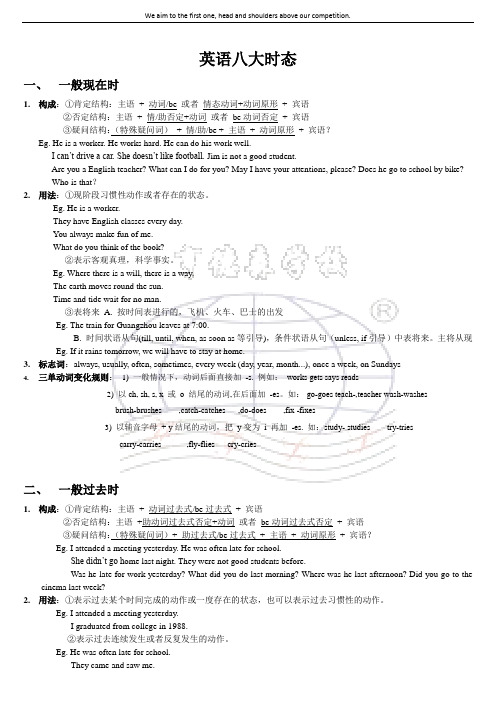
5.不规则变化
六、过去进行时
1.构成:①肯定结构:主语+was/were + doing+ (宾语)
②否定结构:主语+was/were not + doing+ (宾语)
④不能用于进行时的动词:A.表示感觉的(feel, smell, sound, taste)
Eg. The plan sounds good.
B.表示感情、拥有关系、状态或思想的动词:agree, believe, belong, contain, hate, hear, like, love, mind, possess, seem, understand, want等
Eg. I wasgoingto leave when it began to rain.
He looked as if he was about to burst into tears.
③was/were to do和was/were doing:
Eg. I was seeing off my sister at the station the next day.
4)重读闭音节,双写词尾辅音字母加ed.如: preferred(重读在fer前); admittedstopped
三、一般将来时
1.结构:①肯定结构:主语+be going to + do或者will/shall + do+宾语
②否定结构:主语+be not going to + do或者will/shall not + do+宾语
He is not going to play basketball this weekend.
英语的8种时态
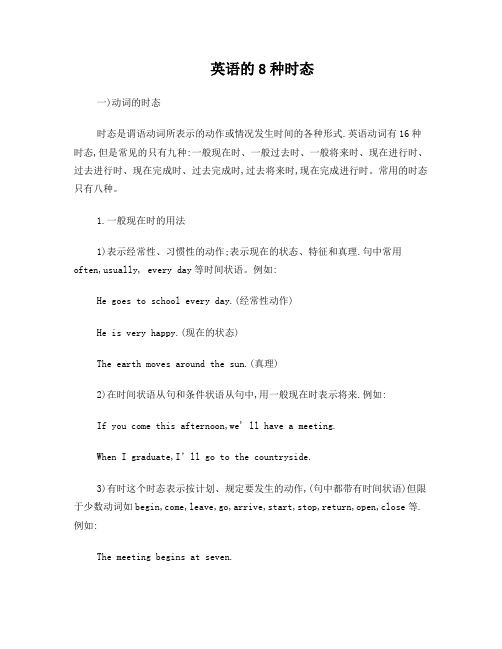
英语的8种时态一)动词的时态时态是谓语动词所表示的动作或情况发生时间的各种形式.英语动词有16种时态,但是常见的只有九种:一般现在时、一般过去时、一般将来时、现在进行时、过去进行时、现在完成时、过去完成时,过去将来时,现在完成进行时。
常用的时态只有八种。
1.一般现在时的用法1)表示经常性、习惯性的动作;表示现在的状态、特征和真理.句中常用often,usually, every day等时间状语。
例如:He goes to school every day.(经常性动作)He is very happy.(现在的状态)The earth moves around the sun.(真理)2)在时间状语从句和条件状语从句中,用一般现在时表示将来.例如:If you come this afternoon,we' ll have a meeting.When I graduate,I’ll go to the countryside.3)有时这个时态表示按计划、规定要发生的动作,(句中都带有时间状语)但限于少数动词如begin,come,leave,go,arrive,start,stop,return,open,close等.例如:The meeting begins at seven.The train starts at nine in the morning.4)表示状态和感觉的动词,如be,like,hate,think,remember,find,sound等常用一般现在时.例如:I like English very much.The story sounds very interesting.5)书报的标题,小说等情节介绍常用一般现在时.2.一般过去时的用法l)表示过去某时间发生的事、存在的状态或过去反复发生的动作.He saw Mr Wang yesterday.He worked in a factory in 19862)表示过去经常发生的动作,也可用“used to”和“would +动词原形”。
8种基本英语时态

8种基本英语时态一、一般现在时 (Simple Present Tense)一般现在时用于描述客观事实、习惯性动作、科学真理等情况。
它的结构是:主语 + 动词原形(第三人称单数加-s)。
例句1:Dogs bark.狗会叫。
例句2:I brush my teeth twice a day.我每天刷牙两次。
例句3:The sun rises in the east.太阳从东方升起。
二、一般过去时 (Simple Past Tense)一般过去时用于表示过去某个时间发生的动作或状态。
它的结构是:主语 + 动词过去式。
例句1:She played basketball yesterday.她昨天打篮球。
例句2:They visited their grandparents last weekend.他们上个周末去看望了他们的祖父母。
例句3:I lived in London for two years.我在伦敦住了两年。
三、一般将来时 (Simple Future Tense)一般将来时用于表示将来发生的动作或状态。
它的结构是:主语+ will + 动词原形。
例句1:I will go to the park tomorrow.我明天将去公园。
例句2:She will study abroad next year.她明年将出国留学。
例句3:They will have a party on Friday.他们将在星期五举办派对。
四、现在进行时 (Present Continuous Tense)现在进行时用于表示现在正在进行的动作。
它的结构是:主语+ am/is/are + 动词-ing。
例句1:He is reading a book now.他现在正在看书。
例句2:We are having dinner at the moment.我们此刻正在吃晚餐。
例句3:They are playing football in the park.他们正在公园踢足球。
初中英语动词八大时态讲解PPT课件

疑问找助动词:do, does
否定找助动词:don’t ,doesn’t
.Hale Waihona Puke 3二、一般过去时 1、be 式动词:
was were 一般过去时 2、实义动词: 使用动词的过去式 (分为规则与不规则) 疑问否定:. did, did’t 4
三 、现在进行时
Is / am /are + doing (注意现在分词的构成)
六、过去完成时:过去的过去
在过去某时间(或动作)看来已经
完成了的动作 :had + done
常见的句型:
①过去完成时 + by the time …
②过去完成时 + by the end of+ 过去的时间
③过去完成时+ when + 一般过去时的句子
④过去完成时+ before + 一般过去时的句子
1、直接+ing
2、去掉e,+
ing
现在进行 时
3、双写+ing
.
5
四、过去进行时 过去进行时
was / were + doing
注意过去进行时与一般过去时的
区别:
1、意义上:过去进行时指过去某
点或某段时间正在进行的动作;而
一般过去时指在过去的时间里所
发生事实。
2、动词使用的形式. 不同
6
五、现在完成时 1、have/ has + done (动作发生在过去对现在造成的 结果或影响) 2、常见的时间状语或句型 ①already,just,ever,never,yet
考点:主句为一般将来时,从句(条件)
用一般现在时。
•We will not go out if it snows tomorrow.
英语的八种时态的结构

英语的八种基本时态包括:一般现在时、一般过去时、一般将来时、过去将来时、现在进行时、过去进行时、现在完成时和过去完成时。
以下是这八种时态的基本结构和用法:1.一般现在时:1.结构:主语+ 动词原形/第三人称单数形式(动词+s/es)+ 其他。
2.用法:描述经常发生的动作或状态,表达普遍真理或习惯性行为。
2.一般过去时:1.结构:主语+ 动词过去式+ 其他。
2.用法:描述过去某个时间发生的动作或状态。
3.一般将来时:1.结构:主语+ will/shall + 动词原形+ 其他;主语+ be going to +动词原形+ 其他;主语+ be to + 动词原形+ 其他;主语+ be about to + 动词原形+ 其他;主语+ be due to + 动词原形+ 其他;主语+ be on the point of + 动名词形式+ 其他。
2.用法:描述将来某个时间将要发生的动作或状态。
4.过去将来时:1.结构:主语+ would/should + 动词原形+ 其他。
2.用法:描述过去某个时间将来要发生的动作或状态。
5.现在进行时:1.结构:主语+ be 动词(am/is/are)+ 现在分词(动词+ing)+ 其他。
2.用法:描述正在进行的动作或状态。
6.过去进行时:1.结构:主语+ be 动词的过去式(was/were)+ 现在分词(动词+ing)+ 其他。
2.用法:描述过去某个时间点正在进行的动作或状态。
7.现在完成时:1.结构:主语+ have/has + 过去分词(动词+ed)+ 其他。
2.用法:描述过去发生的动作对现在造成的影响或结果,或者表示从过去某一时间开始一直持续到现在的情况。
8.过去完成时:1.结构:主语+ had + 过去分词(动词+ed)+ 其他。
2.用法:描述过去某个时间点之前已经完成的动作或状态,或者表示一个过去的动作在另一个过去的动作之前发生。
请注意,以上列出的时态结构和用法是基本的概述,实际使用中可能因语境和习惯而有所不同。
初中英语八大时态详解,满满的干货!
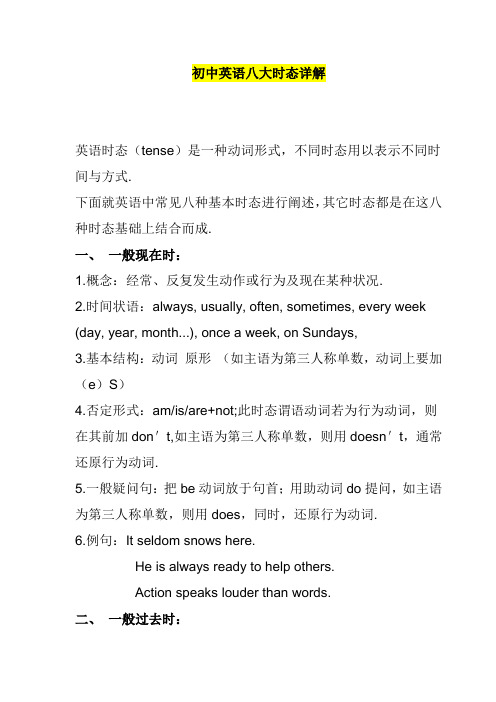
初中英语八大时态详解英语时态(tense)是一种动词形式,不同时态用以表示不同时间与方式.下面就英语中常见八种基本时态进行阐述,其它时态都是在这八种时态基础上结合而成.一、一般现在时:1.概念:经常、反复发生动作或行为及现在某种状况.2.时间状语:always, usually, often, sometimes, every week (day, year, month...), once a week, on Sundays,3.基本结构:动词原形(如主语为第三人称单数,动词上要加(e)S)4.否定形式:am/is/are+not;此时态谓语动词若为行为动词,则在其前加don't,如主语为第三人称单数,则用doesn't,通常还原行为动词.5.一般疑问句:把be动词放于句首;用助动词do提问,如主语为第三人称单数,则用does,同时,还原行为动词.6.例句:It seldom snows here.He is always ready to help others.Action speaks louder than words.二、一般过去时:1.概念:过去某个时间里发生动作或状态;过去习惯性、经常性动作、行为.2.时间状语:ago, yesterday, the day before yesterday, last week(year, night, month…), in 1989, just now, at the age of 5, one day, long long ago, once upon a time, etc.3.基本结构:be动词;行为动词4.否定形式:was/were+not;在行为动词前加didn't,同时还原行为动词.5.一般疑问句:was或were放于句首;用助动词do过去式did 提问,同时还原行为动词.6.例句:She often came to help us in those days.I didn't know you were so busy.三、现在进行时:1.概念:表示现阶段或说话时正在进行动作及行为.2.时间状语:now, at this time, these days, etc.3.基本结构:am/is/are+doing4.否定形式:am/is/are+not+doing.5.一般疑问句:把be动词放于句首.6.例句:How are you feeling today?He is doing well in his lessons.四、过去进行时:1.概念:表示过去某段时间或某一时刻正在发生或进行行为或动作.2.时间状语:at this time yesterday, at that time或以when引导谓语动词是一般过去时时间状语等.3.基本结构:was/were+doing4.否定形式:was/were + not + doing.5.一般疑问句:把was或were放于句首.6.例句:At that time she was working in a PLA unit.When he came in, I was reading a newspaper.五、现在完成时:1.概念:过去发生或已经完成动作对现在造成影响或结果,或从过去已经开始,持续到现在动作或状态.2.时间状语:recently, lately, since…for…,in th e past few years, etc.3.基本结构:have/has + done4.否定形式:have/has + not +done.5.一般疑问句:have或has提前6.例句:I've written an article.It has been raining these days.六、过去完成时:1.概念:以过去某个时间为标准,在此以前发生动作或行为,或在过去某动作之前完成行为,即“过去过去”.2.时间状语:before, by the end of last year(term, month…),etc.3.基本结构:had + done.4.否定形式:had + not + done.5.一般疑问句:had放于句首.6.例句:As soon as we got to the station, the train had left.By the end of last month. We had reviewed four books七、一般将来时:1.概念:表示将要发生动作或存在状态及打算、计划或准备做某事.2.时间状语:tomorrow, next day(week, month, year…),soon, ina few minutes, by…,the day after tomorrow, etc.3.基本结构:am/is/are/going to + do;will/shall + do.4.否定形式:was/were + not; 在行为动词前加won't,同时还原行为动词.5.一般疑问句:be放于句首;will/shall提到句首.6.例句:They are going to have a competition with us in studies.It is going to rain.八、过去将来时:1.概念:立足于过去某一时刻,从过去看将来,常用于宾语从句中.2.时间状语:the next day(morning, year…),the following month(week…),etc.3.基本结构:was/were/going to do;would/should + do.4.否定形式:was/were/not + going to + do;would/should + not + do.5.一般疑问句:was或were放于句首;would/should 提到句首.6.例句:He said he would go to Beijing the next day.I asked who was going there .小结:1.一般现在时: 主语+do/does(现在分词)e.g We clean the room every day.2.一般过去时: 主语+dide.g We cleaned the room just now.3.现在进行时: 主语+am/is/are doinge.g We are cleaning the room now.4.过去进行时: was/were doinge.g We were cheaning the room at 5:00 yesterday afternoon.5.现在完成时: have/has donee.g.We have cleaned the room already.6.过去完成时: had donee.g We had cleaned the room before he arrived.7.一般将来时: will do/e.g We will clean the room tomorrow.8.过去将来时: was/were to /would doe.g He said he would clean the room next.。
英语时态8种基本时态讲解
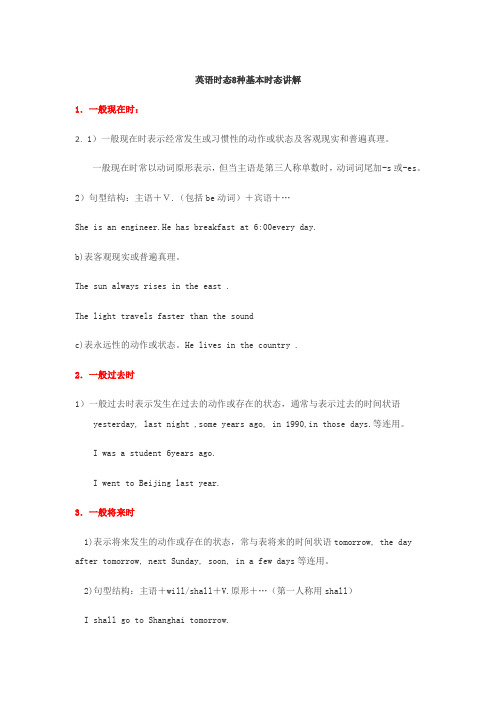
英语时态8种基本时态讲解1.一般现在时:2.1)一般现在时表示经常发生或习惯性的动作或状态及客观现实和普遍真理。
一般现在时常以动词原形表示,但当主语是第三人称单数时,动词词尾加-s或-es。
2)句型结构:主语+V.(包括be动词)+宾语+…She is an engineer.He has breakfast at 6:00every day.b)表客观现实或普遍真理。
The sun always rises in the east .The light travels faster than the soundc)表永远性的动作或状态。
He lives in the country .2.一般过去时1)一般过去时表示发生在过去的动作或存在的状态,通常与表示过去的时间状语yesterday, last night ,some years ago, in 1990,in those days.等连用。
I was a student 6years ago.I went to Beijing last year.3.一般将来时1)表示将来发生的动作或存在的状态,常与表将来的时间状语tomorrow, the day after tomorrow, next Sunday, soon, in a few days等连用。
2)句型结构:主语+will/shall+V.原形+…(第一人称用shall)I shall go to Shanghai tomorrow.They will have a meeting next week..3)主语+will/shall+V.原形+…be(am, is, are)going toThey will have a meeting next Sunday.(will=are going to )4) be about to+V.原形I am about to leave school.4.过去将来时1)过去将来时是立足于过去某时,从过去的观点看将要发生的动作或状态。
英语常用的八种时态
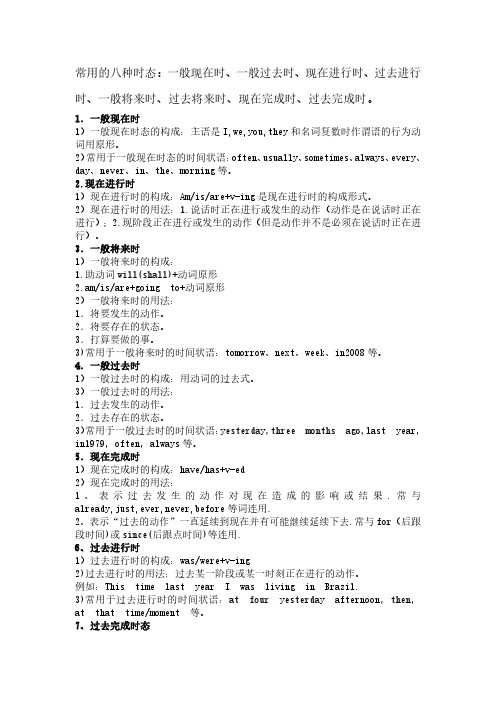
常用的八种时态:一般现在时、一般过去时、现在进行时、过去进行时、一般将来时、过去将来时、现在完成时、过去完成时。
1.一般现在时1)一般现在时态的构成:主语是I,we,you,they和名词复数时作谓语的行为动词用原形。
2)常用于一般现在时态的时间状语:often、usually、sometimes、always、every、day、never、in、the、morning等。
2.现在进行时1)现在进行时的构成:Am/is/are+v-ing是现在进行时的构成形式。
2)现在进行时的用法:1.说话时正在进行或发生的动作(动作是在说话时正在进行);2.现阶段正在进行或发生的动作(但是动作并不是必须在说话时正在进行)。
3.一般将来时1)一般将来时的构成:1.助动词will(shall)+动词原形2.am/is/are+going to+动词原形2)一般将来时的用法:1.将要发生的动作。
2.将要存在的状态。
3.打算要做的事。
3)常用于一般将来时的时间状语:tomorrow、next、week、in2008等。
4.一般过去时1)一般过去时的构成:用动词的过去式。
3)一般过去时的用法:1.过去发生的动作。
2.过去存在的状态。
3)常用于一般过去时的时间状语:yesterday,three months ago,last year,in1979,often,always等。
5.现在完成时1)现在完成时的构成:have/has+v-ed2)现在完成时的用法:1、表示过去发生的动作对现在造成的影响或结果.常与already,just,ever,never,before等词连用.2、表示“过去的动作”一直延续到现在并有可能继续延续下去.常与for(后跟段时间)或since(后跟点时间)等连用.6、过去进行时1)过去进行时的构成:was/were+v-ing2)过去进行时的用法:过去某一阶段或某一时刻正在进行的动作。
例如:This time last year I was living in Brazil.3)常用于过去进行时的时间状语:at four yesterday afternoon,then,at that time/moment等。
英语时态8种基本时态讲解

过去进行时: was/were doing
was/weryou!
far, already, yet, ever, just…
• have/has + P.P(动词过去分词) • I have already read this book. • He has read Harry potter.
• 8.过去完成时
• 表示动作发生在过去某一时间之前 已经完成的动作或状态, 强调 “过去的过去”
• 动词结构 为 be+V-ing
• 基本结构:主语+be(am, is, are)+ v-ing + 其他成分
• You are listening (listen) to me carefully now.
• Look! They are dancing (dance).
• We are studying (study) English at present .
• I was a student 6years ago.
• I went to Beijing last year.
• He was (be)busy yesterday. • They saw (see)a film last night. • He smoked (smoke) last year.
• 6 .过去进行时
• 表示过去某一时刻或某阶段时间正 在进行的动作, 通常与 at 6:00 yesterday, at this/ that time yesterday, when 引导的时间状语等连用。
be (was/were) +v- ing +其他成分
• It was raining (rain)at 7:00 the day before yesterday.
高中英语动词八种时态详解

高中英语动词八种时态详解在英语中,不同时间发生的动作或存在的状态,要用不同的动词形式来表示,这就叫做动词的时态。
一、一般时一般时包括一般现在时、一般过去时、一般将来时和一般过去将来时。
A.一般现在时1.一般现在时的构成一般现在时主要用动词原形来表示。
主语是第三人称单数时,动词后面要加-s或-es。
They want good jobs.他们想要好的工作。
The coat matches the dress.外衣和裙子很相配。
This work does not satisfy me.这项工作我不满意。
Do you understand?你懂了吗?2.一般现在时的用法①一般现在时的基本用法a. 表示现在习惯性的动作或存在状态He always takes a walk after supper.晚饭后他总是散散步。
Everyone is in high spirits now.现在大家都情绪高涨。
b. 表示客观事实或普遍真理The sun rises in the east and sets in the west.太阳从东方升起在西方落下。
Sound travels faster through water than it does through air. 声音在水中的传播速度要比在空气中快。
Time and tide wait for no man.时间不等人。
c. 表示主语的特征、能力和状态This cloth feels soft.这布摸上去很软。
I love classical music.我喜欢古典音乐。
The President still seems able to find time to go fishing.看来总统仍能有时间去钓鱼。
d. 表示按计划或安排将要发生的动作The meeting begins at 7:00.会议七点钟开始。
We leave here at 8:00 sharp.我们八点整离开这里。
初中英语动词八大时态详解
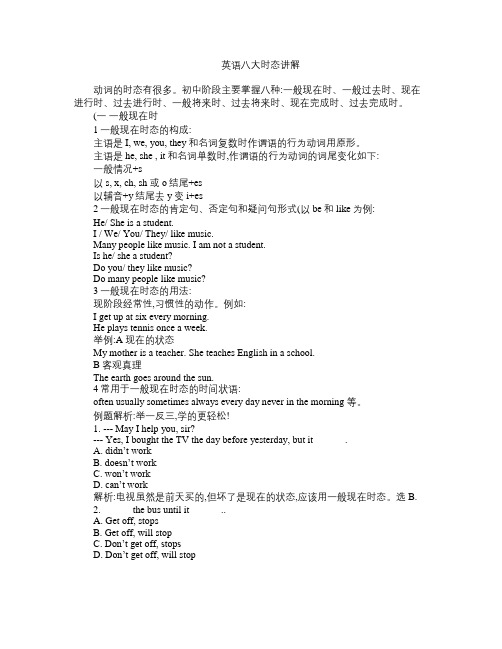
英语八大时态讲解动词的时态有很多。
初中阶段主要掌握八种:一般现在时、一般过去时、现在进行时、过去进行时、一般将来时、过去将来时、现在完成时、过去完成时。
(一一般现在时1一般现在时态的构成:主语是I, we, you, they和名词复数时作谓语的行为动词用原形。
主语是he, she , it和名词单数时,作谓语的行为动词的词尾变化如下:一般情况+s以s, x, ch, sh 或o结尾+es以辅音+y结尾去y变i+es2一般现在时态的肯定句、否定句和疑问句形式(以be和like为例:He/ She is a student.I / We/ You/ They/ like music.Many people like music. I am not a student.Is he/ she a student?Do you/ they like music?Do many people like music?3一般现在时态的用法:现阶段经常性,习惯性的动作。
例如:I get up at six every morning.He plays tennis once a week.举例:A 现在的状态My mother is a teacher. She teaches English in a school.B 客观真理The earth goes around the sun.4常用于一般现在时态的时间状语:often usually sometimes always every day never in the morning 等。
例题解析:举一反三,学的更轻松!1. --- May I help you, sir?--- Yes, I bought the TV the day before yesterday, but it ______.A. didn’t workB. doesn’t workC. won’t workD. can’t work解析:电视虽然是前天买的,但坏了是现在的状态,应该用一般现在时态。
初中英语八大时态讲解_图文

2 have been to+地点,表示“去过某地”
。(人已回) I have been to Europe. (I am not in Europe now.)
3 have been in+地点+时间段,表示“在/ 来某地多久”。
I have been in Europe for three weeks. (I am now still in Europe .)
go there get home open close get to know borrow buy
be there be home be open be closed know keep have
1.The film began 5 The film_h_a_s b_e_en_o_n__ for 5
• 9.They got to know 10 They_h_av_e_k_n_o_w_n__since 10
years ago.
years ago.
• 10.I borrowed the book a I_h_a_v_e _k_e_p_t _the book for a
week ago.
week.
二、一般过去时
1.用法:过去的动作或状态。
2.标志词:
yesterday, the day before yesterday,
three days ago, last night/week/month…,in the past;just
now=a moment ago
例题
Li Ming didn’t understand what American people
4.He joined the club 3 He__h_as_b_e_en_i_n__the club for
初中英语语法动词八种时态详解
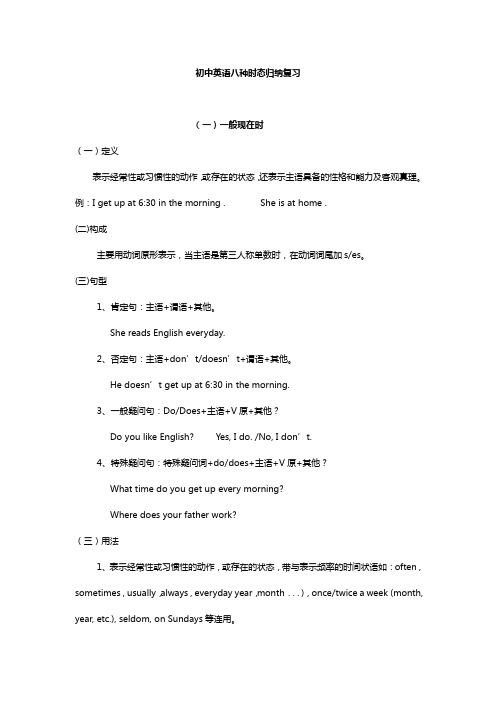
初中英语八种时态归纳复习(一)一般现在时(一)定义表示经常性或习惯性的动作,或存在的状态,还表示主语具备的性格和能力及客观真理。
例:I get up at 6:30 in the morning . She is at home .(二)构成主要用动词原形表示,当主语是第三人称单数时,在动词词尾加s/es。
(三)句型1、肯定句:主语+谓语+其他。
She reads English everyday.2、否定句:主语+don’t/doesn’t+谓语+其他。
He doesn’t get up at 6:30 in the morning.3、一般疑问句:Do/Does+主语+V原+其他?Do you like English? Yes, I do. /No, I don’t.4、特殊疑问句:特殊疑问词+do/does+主语+V原+其他?What time do you get up every morning?Where does your father work?(三)用法1、表示经常性或习惯性的动作,或存在的状态,带与表示频率的时间状语如:often , sometimes , usually,always , everyday year,month...), once/twice a week (month, year, etc.), seldom, on Sundays等连用。
I leave home for school at seven every morning.2、表示客观真理,科学事实、格言警句。
The sun rises in the east .日出东方。
The earth goes around the sun .地球绕着太阳转。
Ten minus two is eight.十减二等于八。
Light travels faster than sound .光的速度比声音的速度快。
初中英语8个时态讲解—中考必考-

初中英语8个时态讲解—中考必考英英英英英英英一般现在时一一一一一一一1、一一一一一一一一一一一。
She often speaks English.I leave home for school at 7 every morning.2、一一一一一一一一一一一一一一一一一一一一。
He seems to feel a bit down today.He works as a driver.3、一一一一一一一一一一一一一一一一一一一一一一。
Shanghai lies in the east of China.Columbus proved that the earth is round.Where there is a will, there is a way.一一一一一一一一一一一一一一一一一一一一一一一一一。
When Bill comes , ask him to wait for me.I shall go there tomorrow unless I’m too busy.一般过去时一一一一一一一一1、一一一一一一一一一一一一一一一一一一。
Jim rang you just now.Liu Ying was in America last year.2、一一一一一一一一一一一一一一,一一一used to do sth.一一一一一一一一一一一一一一一一一一When I was a kid, I often played football in the street.She used to visit her mother once a week.*一一一一:sb. used to do sth.一一一一一一一一一一一一一to一一一一一一一一一一一一sb. be used to sth./doing sth.一一一一一一一一/一一一一一一to一一一一一3、一一一一一一一一一一一一一一一一一一一一一一一一一一一一一一一一一一一一一一一一want, hope, wonder, think, intend一一一一一一一could, would一I wondered if you could have a word with me.I hoped you could help me with my English.Would you mind my sitting here?一般将来时一一一will / shall +一一一一1、一一一一一一一一一一一一一一一。
- 1、下载文档前请自行甄别文档内容的完整性,平台不提供额外的编辑、内容补充、找答案等附加服务。
- 2、"仅部分预览"的文档,不可在线预览部分如存在完整性等问题,可反馈申请退款(可完整预览的文档不适用该条件!)。
- 3、如文档侵犯您的权益,请联系客服反馈,我们会尽快为您处理(人工客服工作时间:9:00-18:30)。
英语八种动词时态讲解1、一般现在时主要用于下面几情况:1) 描述当前时间内经常出现、反复发生的动作或存在的状态。
在这种情景中,句子常带有表示频率的时间状语:always , everyday , often , once a week (month , year , etc.) , sometimes , seldom , usually等等,以表示句中的动作或状态是习惯性的、经常性的。
例如:They raise ducks as a sideline .他们以养鸭为副业。
She doesn't often write to her family, only once a month. 她不常给家里写信,仅一月一封而已。
I cycle to work every day .我每天骑自行车上班。
It seldom rains here .这儿很少下雨。
2)仅为了描述状态、性质、特征、能力等等。
这里的目的是为了"描述现阶段的动作或状态",其重点"不是强调动作发生的时间、或进行的状态"。
例如:He can speak five foreign languages .他能说五种外语。
That is a beautiful city .那是座美丽的城市。
Changjiang River is one of the longest rivers in the world. 长江是世界上最长的河流之一。
She majors in music .她主修音乐。
All my family love football .我全家人都喜欢足球。
My sister is always ready to help others . 我妹妹总是乐于助人。
3) 陈述客观事实、客观真理。
顾名思义,客观的情况是"没有时间概念"的;也"不会在意动作进行的状态"。
例如:The sun rises in the east .日出东方。
The earth goes around the sun .地球绕着太阳转。
Ten minus two is eight.十减二等于八。
Light travels faster than sound .光的速度比声音的速度快。
The United States lies by the west coast of the Pacific Ocean. 美国位于太平洋西岸。
4) 根据英文语法规定,当主句的谓语动词是一般将来时,那么时间或条件状语从句的谓语动词只能用一般现在时来表示将来要发生的动作。
例如:I'll tell him the news when he comes back. 他回来时,我将告诉他这个消息。
If you take the job , they will talk with you in greater details. 如果你接受这份工作,他们将和你谈谈细节。
用于一般现在时的副词,除了上面提到的一些表示频率的以外,常见的还有:now, today , nowadays等等。
2、一般过去时主要是用来描述在过去某个时候发生的动作或存在的状态。
它也可以用来表示在过去某段时间里经常发生的习惯性动作。
这一点在表达意义上与一般现在时相同,只是所在的时间区域不同而已。
由于它的主要作用如此,所以在使用一般过去时的句子里常常有一个意义较具体的过去时间状语。
这也是它与现在完成时的最大区别之一。
一般过去时由谓语动词的过去式表示,也就是说动词词末要加-ed(除不规则动词外)。
常和一般过去时连用的过去时间状语有:last night (week , month , year , century , etc.) , yesterday , the day before yesterday , yesterday morning ( afternoon , evening ) , in 1999 , two hours ago ( one week ago , tree years ago , …)等等。
使用一般过去时,在某种意义上说就是要强调动作或状态发生或存在于过去的某个时候。
"过去"的时间概念有两层意思:一是指"现在某个时间"以前的时间;二是指"说话、写文章的那个时间点"以前的时间,在这个意义上,"现在的那个时间点"是很小很小的,甚至于小到无法量化的程度。
例如:He got his driving license last month. 他上个月拿到了驾照。
--Where's Jim? 吉姆在哪里?--He just went out.他刚刚出去。
3、一般将来时主要用来描述将要发生的动作或存在于未来的情况。
这里所说的"将来时间"是指"说话、写文章那一刻以后的时间"。
它的表示方法主要有如下几种:1)shall / will + 动词原形这种表示方法是说,动作在现在或目前还未发生,要在将来的某个时间内发生;它没有主观性,是"纯粹的将来动作"。
例如:I shall / will not be free tomorrow .我明天没空。
He will arrive here this evening .他今晚抵达这里。
2) be( am / is / are ) + going +不定式这种表示方法主要是说明A)"说话人的意图、打算";B)"某种可能性" 。
例如:A) He is going to spend his holidays in London . 他打算在伦敦度假。
Who is going to speak first? 谁先发言?B) It is going to rain soon .马上要下雨了。
Is he going to collect any data for us? 他会帮我们收集资料吗?If you go to New Zealand, you are going to like the place. 如果你去新西兰,你会喜欢上那个地方的。
3) be( am / is / are ) + 不定式表示方法描述两钟情况:按计划安排要发生的动作,这个动作发生的时间一般不会很远;要求或命令他人做某事。
例如:A) The new bridge is to open to traffic in three days. 新桥三天后通车。
The factory is to go into production before National Day. 这家工厂国庆节前投产。
B) You are not to bring any mobile communication means into the exam-room . 任何移动通讯工具都不得带入考场。
You are to stay home until your mother comes back. 你妈回来之前你不要出去。
4) 用一般现在时或现在进行时(限于某些动词)表示按计划安排要发生的事。
这种表示方法实际上已经在上面"一般现在时之4)"中谈过。
主要强调"按计划安排要发生的事"。
例如:Do you get off at the next stop? 你下一站下车吗?The plane takes off at 11:00 a.m. 那架飞机上午十一点起飞。
Mr. Reider is leaving for New York next week. 里德先生下周动身去纽约。
4、过去将来时表示过去的某时以后将要发生的动作。
但这个"将来"时间绝不会延伸到"现在";而仅限于"过去时间区域内"。
由此可以看出,含这个时态的句子常带一个表示"过去某个时间点"的状语。
这个状语或是一个短语,或是一个句子。
这个时态常用于:A)宾语从句或间接引语中;B)表示过去习惯性的动作;C)表示过去情况中的"愿望"、"倾向",多用于否定句。
例如:A) When I thought about it , I wondered what their reaction would be . 当我考虑这件事时,我想知道他们的反应是什么。
She told me that she would go on trip to Europe the next day. 她告诉我,她第二天要去欧洲旅行。
He didn't expect that we would all be there. 他没料到我们会全在那儿。
B) During that period , he would do morning-exercises every day. 在那段时间,他每天早锻炼。
Whenever he had time, he would help his mother with some housework. 无论他什么时间有空,他总是帮他妈妈干点家务活。
C) No matter how difficult the work was , he would keep on doing it until he accomplished it . 不管工作有多难,他总会坚持不懈地把它干完。
They knew that we would never permit such a thing. 他们知道我们绝不会允许发生这样的事。
Even after the lecture ended, the audience would not leave . 甚至在讲座结束之后,听众仍不肯离去。
5、现在进行时主要用来描述"说话、写文章的当刻"正在发生的动作,或是"现阶段"一直在进行的动作。
它适用于下面的情况:1)"说话、写文章的当刻"正在发生的动作。
例如:They are having a football match .他们正在赛足球。
She is writing her term paper. 她正在写学期论文。
Someone is asking for you on the phone. 有人找你听电话。
2)"现阶段"一直在进行的动作。
这种情况并不是说某个动作在说话的那会儿正在发生,而是说某个动作在当前一段时间内一直在进行着,或是重复地发生着。
